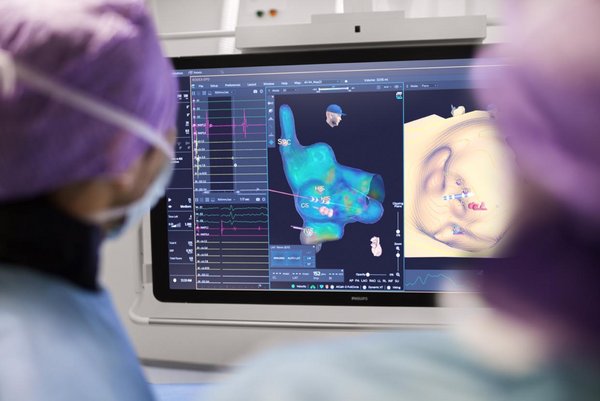
Catharina Hospital is the first in the Netherlands to use a new technique for the treatment of atrial fibrillation
The Catharina Heart and Vascular Center is the first center in the Netherlands to perform Cryoballoon ablation with the KODEX-EPD system. Ablations are performed to treat atrial fibrillation, a heart rhythm disorder.
The KODEX-EPD system from Philips is a completely new technology to create detailed 3D images of the heart structure during procedures on the heart catheterization chamber without the use of X-rays or contrast medium The system uses dielectric sensing technology.
“With this technology, we are able to provide the best treatment in an even safer way and for each individual patient,” says Prof. Lukas Dekker, Cardiologist at Catharina Hospital. “During the treatment, we use less radiation and contrast medium to image the heart. In addition, we can also minimize the examination in a CT or MRI scan beforehand. This is much better for the patient. ”
Worldwide, 33 million people have some form of atrial fibrillation [1]. With patients with atrial fibrillation, there are disturbances in the electrical stimuli in the heart, causing the heartbeat to be irregular and usually too high. This disturbance can be treated by an ablation procedure. The KODEX-EPD System, a cardiac imaging and mapping system, has been specially developed to support the treatment of atrial fibrillation.

Dielectric Sensing
The KODEX-EPD system uses dielectric sensing technology to obtain detailed information about the anatomical structure of the heart. Through an electric field - obtained from the sensors on the patient and the electrodes on the catheter in the heart, and analysed with special software - high-quality 3D images are created without the use of radiation or contrast medium. Dielectric sensing is also used to verify that the Cryoballoon catheter is properly positioned during Cryoablation. The Catharina Hospital is the first center in the Netherlands to use this technology.
Cardiologist Prof. Lukas Dekker is enthusiastic about this new technique: “With this completely new technology, we can already look much better in a three-dimensionally way into the heart and place our Cryoballoon much better for the optimum result. We are working hard to observe even more during the procedure, such as the thickness of the wall, and the scars we make to block the electrical stimuli. ”
The treatments are minimally invasive. A special catheter is guided through the blood vessels to the heart via the groin. Local scar tissue is created by ablation where the cardiac arrhythmia occurs. The physician does this by means of freezing (Cryo) or heating (RF).
Ablation remedies disturbances in the electrical stimuli, which causes for example atrial fibrillation. The scar tissue ensures that the electrical stimuli are blocked.
Sources:
[1] Chugh S, Havmoeller R, Narayanan K, et al. Worldwide epidemiology of atrial fibrillation: a global burden of disease 2010 study. Circulation. 2014; 129:837-847.